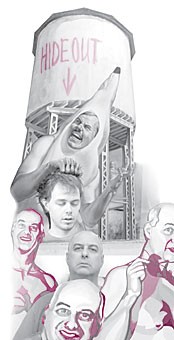How do you let someone into your head?
Is it through a long-winded anecdote, wild gestures thrown in for effect? Or is it through a song written to the only power chords you know, performed in the depths of your basement?
How do you tell the stories that flood your brain?
It is this problem that the artist takes on as a vocation.
Suspended upside down over the mouth of a canyon with yards of white fabric flowing around her, Kate Hodges, a fine arts graduate student, is trying to let you into her head.
Her series, “”Immersion,”” is a photographic account of the performance art and sculpture work she completed over the course of nine months at Malino Canyon, located near Mount Lemmon.
This series is just one from the many artists whose work will be on display for the 2006 Annual MFA Thesis Exhibition opening tomorrow at both the Joseph Gross Gallery and the UA Museum of Art.
At 39 years old, the single Hodges used her project as a way to analyze her views on marriage, resulting in her extensive use of white as a symbol of purity and union.
“”I started to realize I operate differently than the normal paradigm,”” Hodges said. “”My marriage has been to the landscape. I’m immersing myself into the landscape and considering that as a type of marriage.””
Though sculpture is her formal concentration, Hodges has had to document her work in photography. Hodge’s idea of sculpture involves the inclusion of her own body in interaction with the natural environment. In essence, her work is living sculpture represented through photographs recording this past performance piece.
“”I’ve always considered the human body as a sculptural form, and I’ve tried to put the human body into my artwork,”” Hodges said. “”I build sculpture I can climb into.””
It was this same flexibility in using mixed media that attracted David Saling to UA’s master of fine arts program.
“”We’re driven by ideas and content,”” Saling said. “”Technique is second to getting at the idea.””
Saling went to work straight out of high school, but was laid off from his job as a car salesman. Unemployment led him to seriously think about where he wanted to go next.
“”I needed to get an education, and I decided to get an education in something that I was passionate about,”” Saling said. “”I chased the almighty dollar for so long that I thought, ‘If I’m going to get a degree, it’s going to be something that I like.'””
What he liked turned out be a life in the arts. Focusing on two-dimensional art with some forays into sculpture, Saling’s thesis project focuses on gender roles.
His work involves a series of life-sized plywood representations of himself that he modeled after paper doll cutouts.
Saling describes himself as a middle-aged guy who is not in great shape with an interest in female clothing that doesn’t go too far. He wanted to use the project to push the bounds of what is “”appropriate”” gender dress.
“”That’s kind of the point of the work,”” Saling said. “”It’s questioning the idea why can women wear pants but men can’t wear dresses.””
Also commenting on culture through two-dimensional work, fine arts graduate student Katarzyna Cepek explored her unique position as someone straddling two different worlds.
Immigrating from Poland during the harsher times of communist rule, Cepek moved to America when she was 10.
“”I never really felt truly American but I have been away from Poland for too long to feel Polish,”” Cepek said.
Feelings of isolation have emerged from Cepek’s forced displacement, which she communicates through symbols of mementos she couldn’t keep due to her forced exile.
I chased the almighty dollar for so long that I thought, ‘If I’m going to get a degree, it’s going to be something that I like.’
David Saling fine arts graduate student
“”When my family and I left Poland, we were unable to bring much with us,”” Cepek said. “”I have very few family photos and mementos.””
The abrupt uprooting from her home country fuels her work, which is characterized by a strong sense of longing.
“”My work is about longing for a home that does not exist,”” Cepek said. “”I search for a place to belong but find myself never quite fitting into the space I inhabit.””
These are just three of the artists who are part of the MFA Thesis Exhibit. For exposure to the rest of their stories, the formal reception is April 20 from 5 p.m. to 7 p.m. at the Joseph Gross Gallery and the UA Museum of Art. The Exhibition will run through May 14. The exhibition is free to the public.









